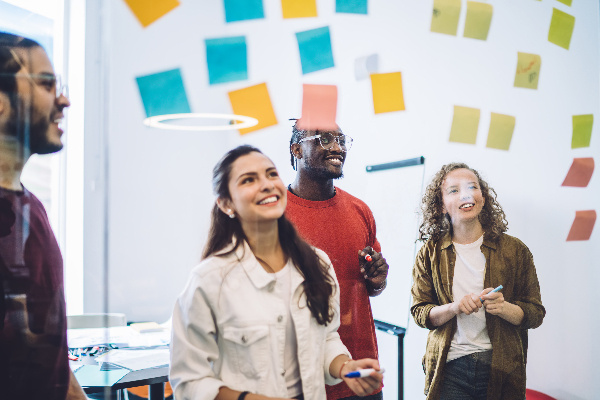Published on
Leading the Change in Higher Ed with Corporate Partnerships

With limited budgets and resources, higher ed can gain a lot from fostering mutually beneficial corporate partnerships, including better meeting student, community and industry needs.
Higher ed is at a point when it needs to constantly adapt to meet the needs of the diverse population looking to stay relevant and competitive in the workforce. And forming meaningful partnerships with community and corporate partners can go a long way in meeting these needs. In this interview, Katonja Webb-Walker discusses the role these partnerships play, the challenges that come with them and how to make a strong partnership last.
The EvoLLLution (Evo): What role do community and corporate partnerships play in the success of continuing education programs?
Katjona Webb-Walker (KWW): We rely on our community and corporate partners to provide us with expertise and access to resources, whether financial or human. They help us inform continuing education curricula and provide resources for innovation. They offer work-based learning opportunities for our students.
When we look at partners for our continuing education programs, we think about them in the same way we think about our credit programs. We take them very seriously. They provide workforce development for our community members along with special interest, which provides great opportunity that credit typically doesn’t have. If someone wants to develop skills for personal use, flexibility and agility are there. While we need dollars, we also need expertise, and our partners can offer that.
Evo: What are some challenges to those community and corporate partnerships?
KWW: Time is always a big challenge. The way to break a partnership that has a lot of potential is going into the conversation without a very clear need or ask—no solid agenda or objectives. There’s plenty of room at the table as long as there’s transparency and you’re looking for help from your partner. You have to be clear about what stage you’re at in the process. You don’t want to waste anyone’s time and have that kind of disorganization.
At City Colleges of Chicago, we have a history of strong partnerships and have a good model. Our district office works with each of the seven colleges. We have an associate vice chancellor and a director who work with workforce development. So, they’re able to share best practices and connections that help support us when needed.
Evo: What are some best practices to overcome these obstacles?
KWW: Going to the table with an understanding of your growth trajectory and vision is key. Every college has a strategic plan, but understanding where continuing education fits in is important. Partners can help you achieve your KPIs and other metrics that you need for the broader institution and student success.
Coming to the table with a partner gives us space to let them know we’re serious. We’re here, and we’ve thought about it. It’s not just an ask but an understanding of how this can be mutually beneficial. And then we leave space for partner input from there.
Evo: What are some characteristics of a strong partnership, and how do you find a partner that will meet your needs and goals?
KWW: There are two main characteristics. The first is responsiveness. Often, we have this great idea but are pulled away to work on something else, but our partner is on the hook and excited to work with us. So, we need to create time and not leave them hanging because of other priorities. Once you engage somebody, you have to give them the attention they need. Otherwise, there’s an inclination to walk away.
The second characteristic of a strong partnership is a sense of mutual benefit. More often than not, partnerships with large community-based organizations or large corporations are not purely philanthropic. There must be something in it for them. It needs to connect their mission or product or generate more workers. So, being clear about the mutual benefit is key.
Evo: How do you measure the impact of community and corporate partnerships?
KWW: We look at the continuing ed side the same way we look at the credit side. Obviously, we’re looking for enrollment. How many students are taking these courses or participating in these workshops? We’re looking at completion, satisfaction and what we call our outcomes measures. We want to know how many of students have graduated and been placed in jobs.
We have partners working with us to help bolster graduation rates and then transfer rates on the side of the special education programs. So, if we have a partnership that offers work-based opportunities or career skills development, we want to know how many have transferred to four-year institutions.
We are partnering with Blue Cross and Blue Shield of Illinois to turn our college into a health hub and offering healthy cooking classes. We’re offering informational workshops on managing diabetes and helping our elders and senior citizens understand how to stay healthy. At the end of many of these workshops, we will send out a survey to get feedback from our students.
Evo: What advice would you give other higher ed leaders looking to strengthen or expand their engagement with their partners?
KWW: Don’t be afraid to approach the big players. Sometimes, as community colleges, we may underestimate what we have to offer. We think the big companies want to work with the large universities. That’s not the case at all.
We’re also tasked with being all things to all people. We have to make sure we’re churning out many different types of programs to meet various professions’ many needs. But we have to make sure we’re providing opportunities for seniors who live in the retirement home across the street to understand the basics of computer use. And we can’t be all things to all people without pulling in resources from outside CBOs or corporations.
So, community colleges, particularly continuing education divisions, do themselves a huge disservice when they don’t understand the value that they bring to the table or don’t convey that value. We can’t be afraid to approach people who really can be of service to us and our students.
Evo: Is there anything you’d like to add?
KWW: As a whole, we know there’s a lot we need to do, and there’s a lot that we can’t do without partners at the table. Our faculty returned for the academic year and had a really robust conversation about how we can maintain status quo with our operating budget. But every year the operating budget remains flat while salaries, services and supplies go up. So, unless we’re able to really establish some solid relationships with corporations and other organizations to help us to figure out how to leverage and generate funds, we’re stuck. If we want to innovate, we really need to make sure we’re shoring up those partnerships.
About three years ago, our institution was gifted $5 million from McKenzie Scott, and we’ve been able to use it to establish a faculty innovation fund. We’ve been able to start new programs. The sheer amount of innovation that we’ve been able to make happen would not have been possible without that relationship and without that gift. So, it propels us to the next level in a way that our typical operating budget just can’t.


